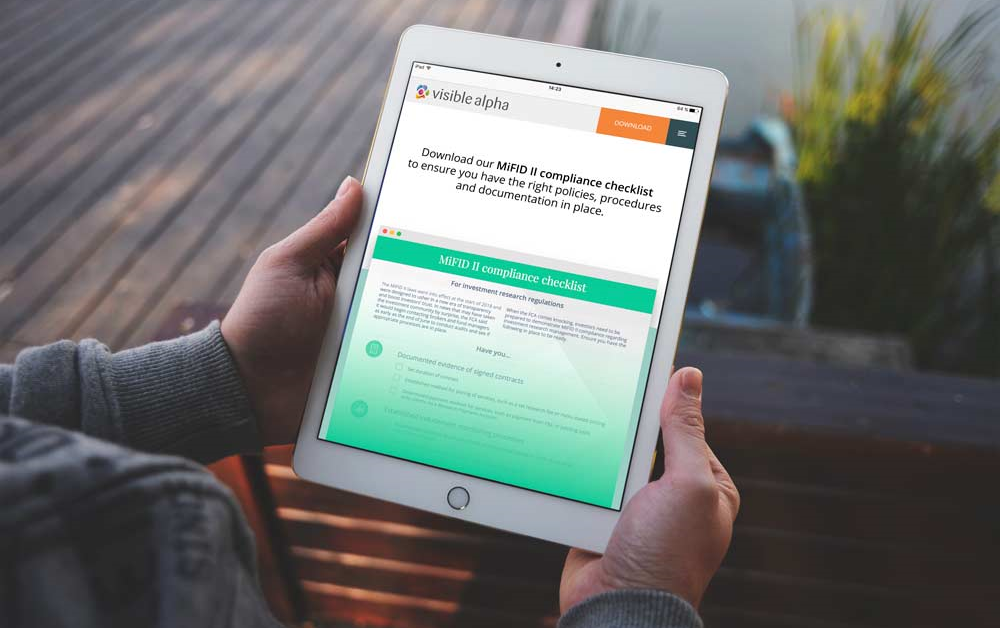By now any buy-side firm that is affected by MiFID II, which rolled out on January 3, 2018, should have a process in place for avoiding inducements during the research process. We’ve gone from the stage of preparing for the new regulation to actually implementing it. While both sides of the market continue to wait with bated breath to see how things will play out, it’s important to regularly review the process you’ve established on how to avoid inducements. Over the next year, we anticipate that processes will need to be tweaked and amended as we learn from each other.
Remember, the purpose of the regulation is to protect investors, ensure that your firm is advancing clients’ goals, and ultimately enhance the quality of service your clients receive. Research can no longer be used as an inducement to trade. MiFID II also aims to improve financial markets operations through more efficiency and transparency.
Unfortunately for the administrative team, the language in MiFID II is a little vague. Even still, the onus of avoiding inducements falls on broker liaisons, operations and other administrative professionals. It’s their responsibility to create the process and enforce it. Investment teams will be a part of this process, but they aren’t the ones creating and enforcing it.
Here are a few ways to avoid inducements and maintain MiFID II compliance.
Establish a clear and shared corporate understanding of the inducement process
An inducement is anything that is perceived as potentially preventing firms from acting in their clients’ best interests. “Arguably, any investment research received by firms from third-party brokers should be considered as a form of inducement” (source). But MiFID II regulations offer that by unbundling research costs from trading costs, inducement risk can be mitigated. So, what represents an inducement at your firm? How should potential inducements be handled? While this is an operational and administrative challenge, it’s important that inducements are clearly defined and everyone knows what to do in order to prevent and limit inducement risk throughout the research process.
Always act in your clients’ best interests
Investment professionals have a fiduciary duty that binds them to work in their clients’ best interests without conflict of interest. It’s the same standard to which lawyers and certified public accounts are held. It’s extremely important to keep your clients’ best interests top of mind; there will be consequences – fines – if you don’t. All this means is to perform due diligence when managing a client’s assets – make decisions based on research and knowledge. The CFA Institute provides a Code of Ethics and Standards of Professional Conduct for investment professionals.
Show value to your clients
Not only is it important to act in your clients’ best interests, but you need to prove you are acting in their best interests. Whether your investment team uses financial models, research reports, corporate access events, bespoke events or a combination of these sell-side resources, you’ll need to show the value of these resources and their impact on your investment recommendations. Use a research management system so analysts and associates can rate research reports and analyst models in real time, which helps in determining the value of those content sets. A formal broker vote will also help in showing value to your clients, as everyone involved with investment research places a quantifiable value on all sell-side interactions.
Review the fundamentals of a broker vote
Have a methodology for research valuation and payment
It’s imperative to have a transparent methodology in place to show how your firm is valuing and paying for research. As research payment amounts cannot be dependent upon transaction volume or the value of the executed transactions, and must be completely unbundled from trading, use a combination of a research tracking tool with rate cards and calculators, and a broker vote to assess the value of reports, models and events. Showing a methodology to how you are tracking, valuing and paying for research proves payment isn’t arbitrary and that research isn’t influencing trading.
Implement an email tracking & classification system
An email tracking and classification platform that flags any potential inducements is a major piece in helping your firm avoid inducements. Email is the primary method of receiving research, yet it’s the least monitored and controlled form of communication. Under MiFID II, all risks of inducements, regardless of entry point, must be managed, and email is a challenge for many firms. As Mike Stepanovich, president of enterprise services at Visible Alpha, points out in this article, “‘An analyst or portfolio manager used to be able to open and read any email, they could use research from anywhere – after January 3rd how do they know which emails they can read and which they can’t?’”
With an email tracking and classification system, your investment team can rest assured that they receive only the research they want, and precious research dollars are only going to the sell-side firms your team finds most useful. If an inducement is received, it will be flagged and the proper steps can be taken to avoid fines and mitigate the risk in the future. Be sure an inducement management process is in place so the investment team knows what to do with a flagged email. Similarly, the administrative team needs to know what steps to take to communicate the misstep to the sell-side firm that sent the inducement.
Reverse Entitlements
Sell-side firms turn the switch on entitlements for buy-side firms. But what happens if a research provider gives you access to their research and events when you don’t want it? You need to have controls in place through reverse entitlements so you are in control of watching over what you should have access to versus what you do have access to. Ideally your reverse entitlements system will allow you to maintain control at the firm, team and individual level, and it will work with your email tracking system to assist in flagging potential inducements.
Watch the news over the coming months
Make sure you have your Google Alerts set and that you’re following your favorite daily newsletters to watch how regulators enforce MiFID II. When a firm is fined for inducements, carefully consider where they went wrong and make any necessary changes to your inducement management process.



